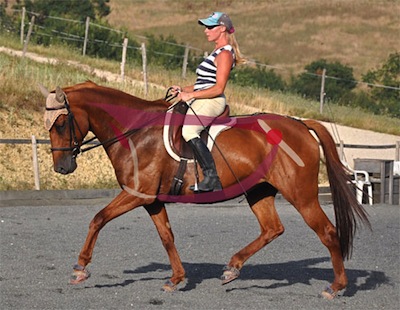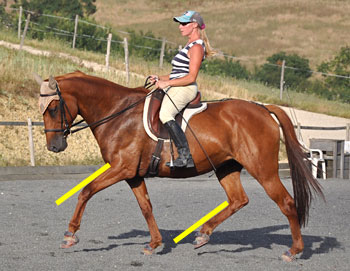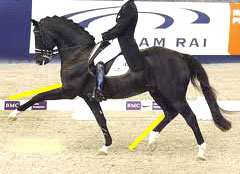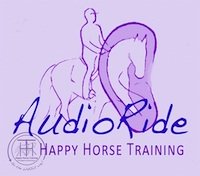|
What does 'on the bit' really mean?The horse being on the bit, or engaged, is a fascinating physiological phenomenon that can apply to all horses, in all spheres, and should be the basis of all riding. In fact, it could easily be said that this is the most important thing that you can understand about riding. Engagement protects the horse, giving him the strength and suppleness to carry the rider comfortably, and it protects the rider because it creates the unity that puts the horse under full control. It gives rise to a whole realm of wonderful sensations between horse and rider, and is the means for the athletic development of the horse's movement, giving it beauty and expression. Engagement, commonly known as the horse being on the bit, is not an additional quality acquired by advanced dressage horses - it should be present to a greater or lesser degree at all levels of a horse's training.
Engagement on the 'ring': the synchronized action of groups of muscles throughout the horse which brings about the longitudinal stretching of the entire spine; the lifting of the abdominal muscles and back; tucking of the pelvis bringing the hind-legs further underneath the body, and the arching of the neck with a soft under-neck muscle. The horse feels to the rider like it 'locks-on' to this postural ring, and the locomotive muscles can then relax rhythmically, giving suppleness and expression to the movement. Note the softness of the contact and the symmetry of the diagonals (see below). The whole horse lifts underneath the rider, giving a feeling of weightlessness and the suspension of the significant unbalanced forces that the horse (and gravity) normally exert on the rider. The biomechanics of the ring of muscles is now well-understood thanks mainly to the fascinating work of Deb Bennett Ph.D. The highlighting of muscles and structures on this image is based on the diagrams in her article “The Ring of Muscles Revisited” available to download here.
|
New from HHT!
AudioRide is a series of exercises designed to listen to while you ride.
Audio descriptions guide you through each step of developing a balanced, dynamic connection with the horse through your position.
This truly innovative learning tool gives you a whole new way of being guided in your riding, in a calm, clear, step-by-step way.
Free Download! Introductory Exercise: Riding in the Now
Click here for full details
The Gymnastic Rider eBook
Now available exclusively from HHT! A unique, comprehensive guide to practical rider biomechanics. This professionally produced eBook takes the rider through the process of developing their body in the specific way that brings the horse's movement into harmony and balance - without force and constraint. Click here for full details, and to download the 15-page introduction for free.
Join the Happy Horse Training group on Facebook!
See and share topical info, news and photo's, and take part in lively discussions.
Click here to go to the HHT group and then click on the 'join group' button.
Join the Whole Horse Newsletter
HHT's free monthly newsletter giving you wide-ranging and intelligent insights into holistic horsemanship.
Just enter your details below to join.
Free bonus on the riding position with all new subscriptions: Ten Top Tips To Instantly Improve Your Connection With Your Horse.
Click here to see back issues of The Whole Horse newsletter
Train Your Horse
The Holistic Way
How To Train A Horse Without Force is a unique guide to training horses through energetic connection and gymnastic training. Part 1 covers everything on the ground, from handling to the lungeing technique that develops strength, straightness and engagement. Comes with a free eBook supplement on Horse Trauma.
Click here for more details.
What people say about the eBook:
"OMG! I'm BLOWN AWAY by this text [...] It's one of the best horse training texts I've ever read." - Wendy Kendall
"I realized that I haven't yet written you about the impact that your training e-book has had on me, and I want to let you know how inspiring and helpful I found it. As a student of Zen Buddhism for nearly three decades, I've often wondered when someone was going to write the book on Zen and the art of horsemanship, and I think that your emphasis on mindfulness and energy connection gets right at the heart of the matter. It has certainly deepened the way that I relate to and communicate with my horses. I am reasonably sensitive to horses' body language and mood, but new to me was the idea of feeling their energy in a more subtle way - including their connection with me even when I am not directly working with the them. I have made myself more aware of this communication, and it's pretty amazing. I have started grooming differently, too, treating a grooming session as a time to mindfully listen to my horse instead of a way to dust out an old rug (OK, I wasn't quite that bad, but you get the idea). Additionally, I have made myself more open to how I actually feel about the horses themselves - very enlightening. Overall, I think that you are saying something that no one else is saying but that everyone ought to hear." - Tess Lloyd
Do You Have
A Horse Story
To Share On HHT?
So many people have been through wonderful experiences with horses, whether in training or otherwise. If you've made a change in a horse's life - or one has made a change in yours - tell us about it here.
Learn How To Trim
Your Own Horse's Feet
The Simple Seven-Step Natural Trim is a comprehensive step-by-step guide to a cutting-edge barefoot trim. Click here to find out more.
What people say about HHT:
"The riding instruction is outstanding, if instructors in the UK taught this way there would be a lot of happy riders and horses."
"The riding tuition exceeded my hopes and expectations by a long way; giving me an exciting new facet to horsemanship which is lighter. more subtle, more elegant and more meaningful. It is as if a new door has opened bringing more sunlight and air."
"My goodness - what a change has taken place in my riding. I think that I'm starting to sit 'into' the horse rather than on top of him. I felt my horse's movements in a way that has almost never happened before"
Click on Testimonials for more






 The yellow lines indicate the angle of the upper foreleg and the lower when this diagonal pair is raised and swinging through. In an engaged ('on the bit') trot these angles are identical i.e. the limbs are parallel, in a reflection of the connection through the horse's whole body created by engagement.
The yellow lines indicate the angle of the upper foreleg and the lower when this diagonal pair is raised and swinging through. In an engaged ('on the bit') trot these angles are identical i.e. the limbs are parallel, in a reflection of the connection through the horse's whole body created by engagement.





